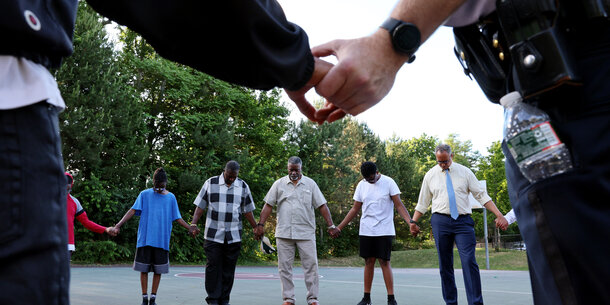This November, California voters face a referendum on ending cash bail, an unfair system that punishes the poor.
Through Proposition 25, voters must decide whether to uphold a law known as Senate Bill 10 (SB-10), which would eliminate cash bail in California, or to keep the current system.
Although the elimination of cash bail is appealing, the law requires judges to use problematic risk assessment tools to guide pretrial detention decisions. Some criminal justice advocates argue that SB-10 gives judges nearly unfettered discretion to detain individuals pretrial and will exacerbate racial inequities in the criminal justice system. However, other advocacy groups support the law.
Voters face a complicated decision. As recently reported by the Public Policy Institute of California (PPIC), the full impact of SB-10 is hard to predict. Current bail practices in California are varied, and a significant case pending before the California Supreme Court may address the constitutionality of cash bail. Regardless of what happens in November, there is significant work ahead for California to implement a fair pretrial system.
Other states — most notably New York and New Jersey — have significantly rolled back cash bail, and it was eliminated in the federal system in 1984. The more places that do so the better, but the new systems should not come with too many drawbacks.
California’s bail reform landscape: SB-10 and Proposition 25
SB-10 was signed into law in 2018 and, if not for California’s bail bonds industry getting a referendum on the ballot, would have gone into effect on October 1, 2019.
A “Yes” vote on Prop 25 would uphold SB-10, making California the first state to entirely eliminate cash bail in favor of a system based on risk. A “No” vote would repeal the law, resulting in the continued operation of California’s current system, which in many jurisdictions includes both cash bail and risk assessment tools.
SB-10 generally requires that people who are arrested for misdemeanors be released within 12 hours. (Some exceptions include people charged with domestic violence, violating a protective order, or stalking, and people who have a recent criminal history, a history of violence, or of violating conditions of pretrial release.) For people charged with felonies or who fall into one of those exceptions, the law creates a pretrial system that relies on judicial discretion and risk assessment tools to determine whether to detain or release people and, if released, under what conditions.
Risk assessment tools, once favored by advocates to help guide judicial discretion, have recently been subject to intense criticism and scrutiny for perpetuating racial, socio-economic, and gender bias. Due to existing disparities in arrest rates, local booking practices, and individual criminal histories, data indicates that serious racial inequities will persist in pretrial detention if the law goes into effect.
If Proposition 25 passes, the PPIC estimates that nearly 40 percent of those arrested and booked into jail would be subjected to a risk assessment under SB-10 — approximately 311,000 people per year. However, because so many California counties already use various risk assessment tools, it is unclear how many arrested people would be subject to a risk assessment if Proposition 25 fails and current practices continue.
Another notable impact of the law is how long people are likely to be detained following arrest. The PPIC estimates about 40 percent of those arrested on misdemeanors (approximately 142,500 people) would likely be released within 12 hours rather than being held for up to two days. In contrast, approximately 1.3 percent of those booked for felonies (approximately 3,000 people) would likely be held longer than under the current system. Rather than posting bail quickly, which is possible in some circumstances, they could be held for up to 36 hours for risk assessment — and then possibly for much longer if a judge concludes they should remain detained. Notably, PPIC’s misdemeanor release estimate may be too high. Due to a lack of available data, its estimate does not consider all 13 exceptions to pretrial release under SB-10, such as people with pending cases or those who have violated a condition of release in the past five years.
To complicate matters for voters, there is also a possibility that the California Supreme Court could invalidate cash bail through a pending case, In re Humphrey — though this is far from certain. In the meantime, the California Supreme Court recently ruled that judges must consider individuals’ ability to pay when imposing or reviewing monetary bail, but research from other jurisdictions raises questions about the effectiveness of ability to pay hearings.
If Prop 25 is rejected
A “No” vote on Proposition 25 means that SB-10 is repealed, and California’s pretrial detention practices remain unchanged. Currently, California’s 58 counties vary greatly in their policies.
Courts across the state use a combination of cash bail and risk assessments in making pretrial release decisions with fifty-one counties using risk assessment tools in some fashion.
At the same time, reliance on cash bail appears to be declining in California, partly in response to the Covid-19 pandemic. In April 2020, the state implemented an emergency bail schedule, which set bail at zero for all individuals charged with misdemeanors and low-level felonies, with some exceptions. As a result, the statewide jail population dropped this year by 22,000, leaving approximately 50,000 people in jail. While the statewide emergency bail schedule was rescinded in June, a majority of counties, covering at least 79 percent of California’s population, have maintained some form of the Covid-19 emergency bail schedule.
In the event of a “No” vote, advocacy organizations are likely to advance an alternative pretrial framework that does not use risk assessments. But only time will tell whether the California Legislature would adopt new measures to eliminate cash bail and reform its pretrial system.
If Prop 25 passes
“Yes” on Proposition 25 would mean that SB-10 goes into effect, which would alter pretrial detention practices in some counties. For jurisdictions already using risk assessments, the bill would have less of an impact.
Unless the prosecution files a motion for detention, the law requires judges to release eligible people on the least restrictive conditions that will “reasonably assure public safety and the defendant’s return to court.” Depending upon an individual’s personal history, charge, and risk assessment score, some will be released on their own recognizance within 24 hours of arrest (low risk), while others may be subject to pretrial supervision (medium risk). If found to be high risk, individuals will be detained until arraignment, which must occur within 48 hours.
At arraignment, the prosecution may make a motion for a detention hearing, possibly resulting in individuals being detained until trial if the judge determines it necessary to assure public safety or a person’s return to court. The prosecution may make such motions in a range of circumstances, including when there is “substantial reason” to believe that no “conditions of pretrial supervision will reasonably assure protection of the public or a victim, or the appearance of the defendant in court.” The law also contains a presumption of detention in certain cases, such as those involving violence or threats of violence, or where an individual has a recent conviction for a crime of violence or is on probation.
The debate over SB-10
As the election nears, public interest organizations and advocates in California are in the odd position of aligning with the bail bonds industry in opposition to SB-10 — although for very different reasons. Critics of the law take particular issue with its use of pretrial risk assessment tools (due to the possibility that they will perpetuate entrenched racial disparities), increased judicial discretion to order detention, presumption of detention in certain cases, and the likelihood that pretrial service agencies will be housed in probation departments.
Other groups believe SB-10 is a positive step forward: it would create a more uniform system that eliminates cash bail in California, bans the practice of making people on pretrial release pay for supervision costs, will likely weaken California’s multi-million dollar bail bonds industry, and should cause thousands of people to be released more quickly from jail, which could offer savings from reduced county jail costs.
Recommendations looking forward
In the event of a “No” vote, thereby repealing the law, California legislators will need to go back to the drawing board to design a fair pretrial system for California. If that occurs, the legislature should design a system that eliminates cash bail without the use of problematic risk assessment tools that entrench racial disparity.
In the event of a “Yes” vote, California must remain diligent in monitoring the use and impact of risk assessment tools and, through legislation or Judicial Council action, should create strict standards for how courts adjust the tools, and encourage, or require, the use of tools that distinguish between risk of flight and risk of committing future crimes.
Though a 2019 law requires all pretrial service agencies to regularly validate their risk assessment tools and publicly report data on any potential biases found, providing some oversight and transparency, it is not enough to resolve concerns of entrenched disparities. Further, if more individuals are on pretrial release, the state should be vigilant in preventing private interests from capitalizing off pretrial supervision. For example, the state should not permit for-profit companies to provide electronic monitoring services.
And, while guarding against interference from private industries, California’s legislature should consider expanding who is permitted to conduct pretrial assessments and supervision beyond public agencies — which will almost certainly be local probation departments — to include nonprofit organizations such as the San Francisco Diversion Project, whose work remains jeopardized by SB-10.
Finally, lawmakers should review how the law, by mandating the placement of pretrial service agencies in public agencies and the use of risk assessment tools, impacts local reform efforts such as those underway in Los Angeles County, and consider legislative carveouts, as was done for the well-established pretrial program in Santa Clara County.
Regardless of Proposition 25’s outcome, California has a great deal of work ahead to design and implement a fair, unbiased pretrial system that maximizes individual liberty while reducing entrenched racial inequities.




